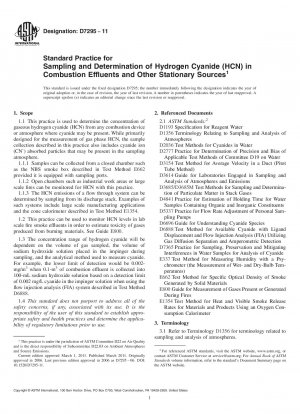ASTM D7295-11
Standard Practice for Sampling and Determination of Hydrogen Cyanide (HCN) in Combustion Effluents and Other Stationary Sources
- Standard No.
- ASTM D7295-11
- Release Date
- 2011
- Published By
- American Society for Testing and Materials (ASTM)
- Status
- Replace By
- ASTM D7295-18
- Latest
- ASTM D7295-18
- Scope
Hydrogen cyanide is highly toxic. In relatively low quantities, hydrogen cyanide can cause asphyxia and death.
The National Fire Protection Association has assigned a flammability rating of 4 (severe fire hazard) to hydrogen cyanide.
1.1 This practice is used to determine the concentration of gaseous hydrogen cyanide (HCN) from any combustion device or atmosphere where cyanide may be present. While primarily designed for the measurement of gas phase HCN, the sample collection described in this practice also includes cyanide ion (CN-) absorbed particles that may be present in the sampling atmosphere.
1.1.1 Samples can be collected from a closed chamber such as the NBS smoke box described in Test Method E662 provided it is equipped with sampling ports.
1.1.2 Open chambers such as industrial work areas or large scale fires can be monitored for HCN with this practice.
1.1.3 The HCN emissions of a flow through system can be determined by sampling from its discharge stack. Examples of such systems include large scale manufacturing applications and the cone calorimeter described in Test Method E1354.
1.2 This practice can be used to monitor HCN levels in lab scale fire smoke effluents in order to estimate toxicity of gases produced from burning materials. See Guide E800.
1.3 The concentration range of hydrogen cyanide will be dependent on the volume of gas sampled, the volume of sodium hydroxide solution placed in the impinger during sampling, and the analytical method used to measure cyanide. For example, the lower limit of detection would be 0.002-mg/m3 when 0.1-m3 of combustion effluent is collected into 100-mL sodium hydroxide solution based on a detection limit of 0.002 mg/L cyanide in the impinger solution when using the flow injection analysis (FIA) system described in Test Method D6888.
1.4 This standard does not purport to address all of the safety concerns, if any, associated with its use. It is the responsibility of the user of this standard to establish appropriate safety and health practices and determine the applicability of regulatory limitations prior to use.
ASTM D7295-11 Referenced Document
- ASTM D1193 Standard Specification for Reagent Water
- ASTM D1356 Standard Terminology Relating to Sampling and Analysis of Atmospheres*, 2024-04-22 Update
- ASTM D2036 Standard Test Methods for Cyanides in Water
- ASTM D2777 Standard Practice for Determination of Precision and Bias of Applicable Methods of Committee D-19 on Water
- ASTM D3154 Standard Test Method for Average Velocity in a Duct (Pitot Tube Method)*, 2023-01-01 Update
- ASTM D3614 Standard Guide for Laboratories Engaged in Sampling and Analysis of Atmospheres and Emissions
- ASTM D3685/D3685M Standard Test Methods for Sampling and Determination of Particulate Matter in Stack Gases
- ASTM D4841 Standard Practice for Estimation of Holding Time for Water Samples Containing Organic and Inorganic Constituents*, 2018-10-15 Update
- ASTM D5337 Standard Practice for Flow Rate for Calibration of Personal Sampling Pumps
- ASTM D6696 Standard Guide for Understanding Cyanide Species*, 2023-11-15 Update
- ASTM D6888 Standard Test Method for Available Cyanides with Ligand Displacement and Flow Injection Analysis (FIA) Utilizing Gas Diffusion Separation and Amperometric Detection*, 2023-11-15 Update
- ASTM D7365 Standard Practice for Sampling, Preservation and Mitigating Interferences in Water Samples for Analysis of Cyanide*, 2022-05-01 Update
- ASTM E1354 Standard Test Method for Heat and Visible Smoke Release Rates for Materials and Products Using an Oxygen Consumption Calorimeter
- ASTM E337 Standard Test Method for Measuring Humidity with a Psychrometer (the Measurement of Wet- and Dry-Bulb Temperatures)
- ASTM E662 Standard Test Method for Specific Optical Density of Smoke Generated by Solid Materials
- ASTM E800 Standard Guide for Measurement of Gases Present or Generated During Fires
ASTM D7295-11 history
- 2018 ASTM D7295-18 Standard Practice for Sampling Combustion Effluents and Other Stationary Sources for the Subsequent Determination of Hydrogen Cyanide
- 2011 ASTM D7295-11 Standard Practice for Sampling and Determination of Hydrogen Cyanide (HCN) in Combustion Effluents and Other Stationary Sources
- 2006 ASTM D7295-06 Standard Practice for Sampling and Determination of Hydrogen Cyanide (HCN) in Combustion Effluents and Other Stationary Sources
